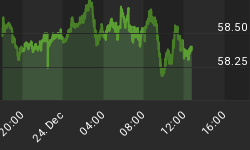Improving Economy
The good news is good news scenario is one where the markets focus on an improving economy. The good news is bad news scenario speaks to an increasingly likelihood the Federal Reserve cuts back on stimulative measures as the economy improves.

If good news is bad news, then the markets received some bad news this morning on the labor front. From Reuters:
New claims for jobless benefits dropped last week to their lowest level in four months, a positive sign for hiring that could bolster expectations the Federal Reserve will ease its monetary stimulus this year. Initial claims for state unemployment benefits fell by 24,000 to a seasonally adjusted 334,000, the Labor Department said on Thursday. It was the lowest reading since March and a steeper fall than analysts had expected.
Is Good News Now Good News?
As lunch time on the east coast was approaching, the S&P 500 was up 10 points. If the gains can be carried into Thursday's close, it would provide some evidence for the "we are beginning to focus on an improving economy" scenario. From Bloomberg:
"Bernanke is really guiding the market so that there are no real shocks when Fed actions do take place," Jonathan Aldrich-Blake, who helps oversee about $10 billion at Ashburton Ltd., said by phone from Jersey, Channel Islands. "The 'bad news is good news' we saw in the market earlier this year is starting to die down as people have more belief in this recovery."
Bad Start, But Still Healthy
Tech stocks seemed to be focusing on the "bad news" scenario with a rough start to Thursday's trading session. After reporting disappointing results, Intel (INTC) was down over 3%. However, longer-term the NASDAQ (QQQ) still looks healthy from a technical perspective. As noted in last week's video, not too many bad things happen as long as (a) Wm %R remains above upper -20 line and (b) the slope of the NASDAQ's 22-week moving average is positive. Wm %R is used to monitor market momentum. As long as the chart looks like this (see below), odds favor bullish outcome looking out several weeks.

Investment Implications
Many traders were waiting to see if the S&P 500 could muster a new closing high and a new intraday high. The closing high was made earlier this week with a final print above the May high of 1669. Thursday the S&P 500 exceeded the May intraday high of 1687. The longer the S&P 500 holds these levels, the easier it is to continue with a bullish portfolio.

Our plan remains basically the same. As long as the economic data allows the markets to continue to favor a risk-on allocation, we will overweight U.S. stocks (SPY) and leading sectors, such as financials (XLF), technology (QQQ), and small caps (IWM). Any move by the S&P 500 back below 1687 and/or 1669 would give us pause relative to redeploying what has become a relatively small cash position.
















